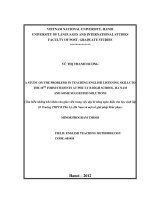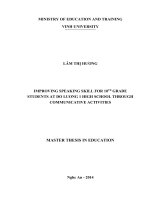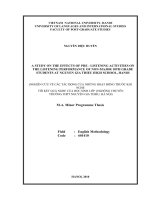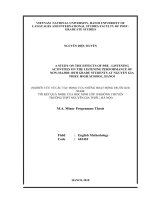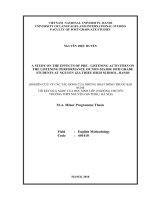skkn cấp tỉnh ome solutions to help 10th grade students at tinh gia 1 high school work in pairs and groups effectively in teaching and learning english
Bạn đang xem bản rút gọn của tài liệu. Xem và tải ngay bản đầy đủ của tài liệu tại đây (179.91 KB, 25 trang )
<span class="text_page_counter">Trang 1</span><div class="page_container" data-page="1">
SỞ GIÁO DỤC VÀ ĐÀO TẠO THANH HOÁ
<b>TRƯỜNG THPT TINH GIA 1</b>
INITIATIVE EXPERIENCE
<small> </small>
<b>TINH GIA 1 HIGH SCHOOL WORK IN PAIRS AND GROUPSEFFECTIVELY IN TEACHING AND LEARNING ENGLISH</b>
</div><span class="text_page_counter">Trang 2</span><div class="page_container" data-page="2"><b> </b>
<b>1. INTRODUCTION:……….…..…<small>…</small><sup>3</sup></b>
1.1. The reasons for choosing this theme:...………..…….…... <small>3</small>
1.2. The purpose of the research:………..……..…... <small>4</small>
1.3. The scope of the research:………..……….…... <small>4</small>
1.4. Methods of the research: ………... <small>6</small>
<b>2. CONTENT……….…<small>...</small><sup>8</sup></b>
2.1. Theorical foundation of this theme: ……….…... <small>8</small>
2.2. The current situation of the issue ………... <small>9</small>
2.3. Definition of pair work and group work………..…... <small>10</small>
2.4. The solutions and the implementation ………..……. <small>11</small>
2.4.1. Enhencing Students Engagement………... <small>11</small>
2.4.2. Improving Classroom Managements………... <small>15</small>
<i><b>2.4.3. Providing Adequate Resources ………...</b></i> <small>18</small>
2.4.4. Developing Effective Assessment Methods ………... <small>18</small>
2.5. Results after applying……….. ………... <small>20</small>
<b>3. CONCLUSION AND RECOMMENDATION………..………<small>…...</small><sup>23</sup></b>
</div><span class="text_page_counter">Trang 3</span><div class="page_container" data-page="3"><b> </b>
<b>1. THE INTRODUCTION</b>
<b>1.1 The reasons for choosing this theme.</b>
On December 26, 2018, the Minister of Education and Training issued anew general education program accompanied by Circular No. 32/2018/TT -BGDDT. In addition to innovating the general education program, it also aimsto innovate teaching methods. Innovating teaching methods is the central taskof current general education innovation. According to the perspective ofteaching and developing capacity, the teaching method not only focuses onactively engaging students in knowledge acquisition activities but also paysspecial attention to forming and developing problem-solving capacityassociated with learning. situations of life and career, and at the same timeassociated with practical and practical activities. Not only that, strengtheninggroup activities and innovating the relationship between students and teachersin the direction of collaboration are important to develop social capacity forstudents. Therefore, in addition to learning the specific knowledge and skills ofthe subject, it is necessary to supplement complex learning topics to developthe ability to solve complex common problems.
As an English teacher for Grade 10 in Tinh Gia 1 high school, I haveobserved that collaborative learning through pair and group activitiessignificantly enhances students' language acquisition and overall classroom
<b>engagement. The theme " Some solutions to help 10th grade students in</b>
<b>Tinh Gia 1 high school work in pairs and groups effectively in learningEnglish " was chosen for several compelling reasons. Pair and group work</b>
encourage students to practice speaking, listening, reading, and writing in asupportive environment, promoting rapid and effective language skilldevelopment. These activities require active involvement, reinforcingunderstanding and retention of the material. Additionally, working togetherhelps students develop essential social skills such as communication,cooperation, and conflict resolution, which are vital for both language learningand personal development. Exposure to diverse perspectives enriches theirlearning experience, fostering critical thinking and creativity. Collaborationalso boosts motivation and confidence, making learning more enjoyable andless intimidating. Moreover, practicing teamwork and communication preparesstudents for real-world scenarios, enhancing their readiness for future academicand professional environments. Aligning with the "Global Success" textbook'semphasis on communicative competence and interactive learning, thesemethods maximize the textbook's potential. In summary, this theme aims to
</div><span class="text_page_counter">Trang 4</span><div class="page_container" data-page="4">create a dynamic, interactive, and supportive learning environment thatimproves English proficiency and prepares students for future challenges.
<b>1.2 The purpose of this theme</b>
<b>The purpose of the theme " Some solutions to help 10th grade students</b>
<b>in Tinh Gia 1 high school work in pairs and groups effectively in learningEnglish " is to enhance the overall learning experience and outcomes for</b>
students. By focusing on collaborative learning techniques, this initiative aimsto achieve several key objectives:
Improve Language Skills: To provide students with ample opportunitiesto practice and refine their speaking, listening, reading, and writing skills in acollaborative setting.
Increase Student Engagement: To foster a more engaging and interactiveclassroom environment where students are actively involved in their learningprocess.
Develop Social Skills: To help students build essential social skills, suchas communication, teamwork, and conflict resolution, which are crucial fortheir academic and personal growth.
Enhance Critical Thinking: To expose students to diverse perspectivesand ideas through group interactions, thereby promoting critical thinking andcreativity.
Boost Confidence and Motivation: To increase students' confidence andmotivation by creating a supportive and encouraging learning environmentwhere they feel comfortable to express themselves.
Prepare for Real-World Applications: To equip students with the skillsnecessary for effective teamwork and communication, preparing them for real-world academic and professional situations.
Align with Educational Goals: To ensure that the teaching methods alignwith the communicative and interactive learning goals of the "Global Success"textbook, thereby maximizing its educational benefits.
By implementing effective pair and group work methods, this themeseeks to create a more dynamic and supportive learning environment that notonly improves students' English proficiency but also prepares them for futureacademic and professional challenges.
<b>1.3 The Scope of the research1.3.1 The setting of the study</b>
The study was conducted at Tinh Gia 1 high school, located in Nghi Son,Thanh Hóa, during the academic year 2023-2024. The participants in the studywere students enrolled in Grade 10, utilizing the "Global Success" Englishtextbook as part of their curriculum. This particular textbook is designed to
</div><span class="text_page_counter">Trang 5</span><div class="page_container" data-page="5">enhance students' language skills through a variety of interactive and engagingactivities, emphasizing both individual and collaborative learning.
The class size varied between 37 to 44 students, reflecting a typicalclassroom setting in Vietnam. The students came from diverse backgroundswith varying levels of English proficiency. This provided a rich environmentfor implementing and evaluating different pair and group work strategies. Theclassroom was equipped with basic teaching aids, including a board, television,which supported the interactive nature of the lessons.
Throughout the study, different methods to facilitate effective pair andgroup work were introduced, such as structured pair activities, role-plays,group discussions, and cooperative learning tasks. The aim was to create anengaging learning environment that not only improved students' Englishlanguage skills but also their ability to work collaboratively.
Data collection involved a combination of qualitative and quantitativemethods, including classroom observations, student surveys, and assessmentsof both individual and group performances. The observations focused onstudent interactions, participation levels, and the overall effectiveness of theactivities in enhancing language acquisition. Surveys were used to gatherstudents' feedback on their experiences and preferences regarding pair andgroup work.
By examining the implementation of these methods in a real classroomsetting, this study aimed to identify best practices and provide practicalrecommendations for other educators looking to enhance collaborative learningin their own classrooms using the "Global Success" English textbook.
<b>1.3.2 The respondents of the study </b>
The respondents of this study were students from 10D3 and 10D8 inTinh Gia 1 high school, Nghi Son, Thanh Hóa. The total number of participantswas 81, with 44 students in Class 10D3 and 37 students in Class 10D8. Thesestudents were selected based on their enrollment in the English course thatutilizes the "Global Success" textbook.
The demographic profile of the respondents included a mix of male andfemale students aged 15-16 years. The students came from diversesocioeconomic backgrounds, reflecting the general student population of theschool. Their proficiency in English varied, with some students demonstratingadvanced skills while others were at a more basic level. This diversity inlanguage ability provided a comprehensive overview of the effectiveness of themethods being studied.
Class 10D3 and Class 10D8 were chosen for their representative natureof the overall Grade 10 population at the school. The selection ensured a
</div><span class="text_page_counter">Trang 6</span><div class="page_container" data-page="6">balanced representation of students with different learning styles and academicabilities. Additionally, the students had prior experience with pair and groupactivities in their English classes, making them suitable respondents forevaluating the proposed methods.
The teacher, who also served as the researcher, had been instructingthese students since the beginning of the academic year. This familiarityallowed for a more nuanced understanding of each student's learning needs andbehavior during collaborative activities. The teacher's insights into the students'dynamics and previous performance in pair and group work were instrumentalin tailoring the methods to enhance effectiveness.
Overall, the respondents' varied backgrounds and English proficiencylevels provided a rich context for examining the effectiveness of differentmethods to facilitate pair and group work in the Grade 10 English classroomusing the "Global Success" textbook.
<b>1.4 Methods of the research</b>
This research aimed to identify and evaluate effective methods toenhance students' ability to work in pairs and groups while learning Englishfrom the Grade 10 "Global Success" textbook. To achieve this objective, acombination of qualitative and quantitative research methods was employed.
<i><b>1.4.1. Research Design</b></i>
The study utilized a quasi-experimental design with both pre-test andpost-test measures to assess the effectiveness of various collaborative learningstrategies. The research was conducted over a 12-week period, divided intothree phases: initial assessment, intervention, and final assessment.
<i><b>1.4.2. Participants</b></i>
The participants were 81 Grade 10 students from Tinh Gia 1 high school,divided into two classes: Class 10D3 (44 students) and Class 10D8 (37students). These students were selected based on their enrollment in theEnglish course using the "Global Success" textbook.
<i><b>1.4.3. Data Collection MethodsPre-test and Post-test Assessments:</b></i>
Pre-test: At the beginning of the study, a pre-test was administered toassess the students' initial proficiency in English and their baseline ability towork in pairs and groups.
Post-test: At the end of the study, a post-test was conducted to measureany improvements in the students' language skills and collaborative abilities.
Classroom Observations:
</div><span class="text_page_counter">Trang 7</span><div class="page_container" data-page="7">Systematic observations were carried out throughout the interventionphase. The focus was on student interactions, participation levels, and theeffectiveness of the pair and group activities.
A structured observation checklist was used to ensure consistency and torecord specific behaviors related to collaboration and communication.
<i><b>Student Surveys and Questionnaires:</b></i>
Surveys were administered to gather students' feedback on theirexperiences with the pair and group activities. The questionnaires includedboth closed and open-ended questions to capture quantitative data andqualitative insights.
Topics covered in the surveys included students' perceptions of theactivities, their comfort levels with collaborative work, and their self-assessedimprovements in English proficiency.
<i><b>Interviews and Focus Groups:</b></i>
Semi-structured interviews were conducted with a select group ofstudents from each class to gain deeper insights into their experiences andopinions about the pair and group work methods.
Focus groups were also held to facilitate discussions among students,allowing them to share their thoughts and suggestions for improving thecollaborative activities.
Group Discussions and Projects:
Activities that required students to work together to completeassignments, solve problems, and engage in discussions on various topics.
Cooperative Learning Techniques:
Methods such as jigsaw activities, think-pair-share, and groupinvestigations to promote interdependence and individual accountability.
</div><span class="text_page_counter">Trang 8</span><div class="page_container" data-page="8">Pre-test and post-test scores were compared using statistical methods todetermine the effectiveness of the interventions.
Survey responses were analyzed to identify trends and patterns instudent feedback.
By employing a comprehensive and mixed-methods approach, this studyaimed to provide a detailed evaluation of the strategies used to enhance pairand group work in the Grade 10 English classroom using the "Global Success"textbook
<b>2. THE CONTENT</b>
<b>2.1. Theorical foundation of this theme</b>
Collaborative learning, particularly through pair and group work, is acornerstone of modern educational practices. In the context of teaching Englishas a foreign language (EFL), these methods are particularly effective inenhancing students' communication skills, fostering critical thinking, andcreating a more engaging learning environment. This theoretical foundationexplores the underpinnings of using pair and group work to help students workeffectively in learning English from the Grade 10 Global Success book.Vygotsky's Social Constructivism, especially his concepts of the Zone ofProximal Development (ZPD) and scaffolding, suggests that students canachieve higher levels of understanding and skill development when theycollaborate with peers. In pair and group work, students can support each other,enabling each member to perform tasks they might not accomplishindependently. Teachers can provide scaffolding by guiding pair and groupactivities, gradually transferring responsibility to the students. This approachhelps students internalize language structures and functions more effectively.Communicative Language Teaching (CLT) theories, such as the InteractionHypothesis and Task-Based Language Teaching (TBLT), emphasize theimportance of interaction and completing tasks in pairs or groups. These tasks
</div><span class="text_page_counter">Trang 9</span><div class="page_container" data-page="9">simulate real-life situations, promoting practical language use and enhancingcommunicative competence. Cooperative Learning Theory, as theorized byJohnson and Johnson, highlights positive interdependence and individualaccountability, encouraging accountability and collective responsibility amongstudents. Pair and group work in EFL offers numerous benefits. Increasedinteraction maximizes student talk time, providing ample practiceopportunities, while real-time feedback allows students to correct errors andrefine their language use. Collaboration and teamwork foster essential socialskills such as cooperation, negotiation, and conflict resolution, promotingcultural awareness and sensitivity. Collaborative activities are typically moreengaging than traditional lecture-based instruction, increasing studentmotivation and interest in learning English. The collaborative setting creates asupportive learning environment where students feel more comfortable takingrisks and experimenting with the language. Effective implementation strategiesinclude providing clear instructions and defining roles within groups, forminggroups with diverse skill levels and backgrounds, and incorporating regularreflection sessions and feedback mechanisms. These strategies help ensure thatall students understand their responsibilities, learn from each other's strengths,and continuously improve their collaborative learning experiences. Thetheoretical foundation of using pair and group work in teaching English isrooted in well-established educational theories and practices. By leveragingthese collaborative methods, teachers can create a dynamic and effectivelearning environment that not only improves language acquisition but alsofosters essential social and cognitive skills among students. The Grade 10Global Success book provides an excellent framework for implementing thesemethods, ensuring students achieve their full potential in learning English.
<b>2.2. Practical background </b>
In recent years, the implementation of pair and group work in theEnglish language classroom has become increasingly prevalent, particularly inthe context of teaching English to Grade 10 students using the Global Successbook. Despite the recognized benefits of these collaborative learning methods,several challenges and issues persist that hinder their effective application.
<i><b>Student Engagement and Participation</b></i>
One of the primary issues observed is the varying levels of studentengagement and participation during pair and group activities. Some studentsactively participate and benefit from these interactions, while others remainpassive, contributing minimally to the group's efforts. This disparity oftenstems from differences in language proficiency, confidence levels, andindividual learning styles. Students with higher proficiency and confidence
</div><span class="text_page_counter">Trang 10</span><div class="page_container" data-page="10">levels tend to dominate discussions, leaving less confident students reluctant toparticipate fully.
<i><b>Classroom Management</b></i>
Managing a classroom where pair and group work are frequently utilizedcan be challenging. Teachers often face difficulties in ensuring that all groupsremain on task and productive. Noise levels can escalate, leading to a chaoticenvironment that is not conducive to effective learning. Additionally, somestudents may use group activities as an opportunity to socialize rather thanfocus on the assigned tasks, further detracting from the educational objectives.
<i><b>Resource Constraints</b></i>
Limited resources and materials pose another significant challenge.Effective pair and group work require sufficient resources such as handouts,audio-visual aids, and other interactive materials that facilitate collaborativelearning. In many instances, schools may lack the necessary funding or accessto these resources, making it difficult for teachers to implement pair and groupactivities effectively.
<i><b>Teacher Preparedness and Training</b></i>
The success of pair and group work largely depends on the teacher'sability to design and facilitate these activities. However, many teachers report alack of adequate training and professional development in this area. Withoutproper guidance and support, teachers may struggle to create engaging andmeaningful pair and group activities that align with the curriculum objectivesof the Grade 10 Global Success book.
<i><b>Assessment and Evaluation</b></i>
Assessing students' performance in pair and group work presents its ownset of challenges. Traditional assessment methods often focus on individualperformance, making it difficult to evaluate the collective effort and individualcontributions within a group setting. This can lead to discrepancies in gradingand a lack of accountability among students.
Addressing these issues requires a multifaceted approach that includesenhancing student engagement, improving classroom management strategies,providing adequate resources, offering professional development for teachers,and developing effective assessment methods. By tackling these challenges,educators can create a more conducive environment for pair and group work,ultimately helping students work more effectively and achieve better outcomesin learning English from the Grade 10 Global Success book.
<b>2.3. Definitions of pair work and group work2.3.1. Definition of pair work </b>
</div><span class="text_page_counter">Trang 11</span><div class="page_container" data-page="11">Pair work is learners working together in pairs. One of the main motivations toencourage pair work in the English language classroom is to increase theopportunities for learners to use English in the class.
<b>2.3.2. Definition of group work </b>
Group work is defined as more than one person working together tocomplete a task or assignment. In the classroom, group work can take manyforms, however, the goal remains the same--get students to interact with eachother and collaborate to complete a unified task. By doing so, we are gettingstudents to work with people they may never have chosen to work with. Thisconcept teaches diversity, communication, and compromise.
There is a tendency of teacher- dominated lesson and students usuallyget bored with teacher- centered presentation. Teachers at high schools are inthe period of getting used to new English textbook. Pair work and group workdidn’t use to be organized in class, so a lot of us – teachers of English at highschool – get stuck in organizing pair work and group work effectively. Someteachers haven’t been clearly aware of the roles of pair work and group work inteaching and learning a foreign language. A few teacher reject the possibility ofsuccess of pair and group work. They give different reasons for their belief,some of the reasons are lack of resources, students use mother tongue duringpair and group work , discipline problem due to noise generated during pairand group work activities and so on.
As a result, despite being an important part of collaborative teaching andlearning, pair and group work generally neglected in teaching English at highschool.
<b>2.4. The solutions and the implementation</b>
To address the challenges of helping students work effectively in pairsand groups while learning English from the Grade 10 Global Success book,several strategies can be employed. These solutions focus on enhancing studentengagement, improving classroom management, providing adequate resources,offering professional development for teachers, and developing effectiveassessment methods.
<i><b>2.4.1. Enhancing Student Engagement</b></i>
<i><b>Interactive Activities: Design activities that are engaging and relevant to</b></i>
students' interests. Incorporate games, role-playing, and real-life scenarios tomake learning more appealing.
</div><span class="text_page_counter">Trang 12</span><div class="page_container" data-page="12"><i><b>Differentiated Instruction: Tailor activities to cater to different</b></i>
proficiency levels within the classroom. This ensures that all students arechallenged appropriately and can participate meaningfully.
<i><b>Enhancing Student Engagement: Step-by-Step GuideStep 1: Design Interactive Activities</b></i>
<i><b>Identify Student Interests</b></i>
Conduct surveys or informal interviews to understand the interests andhobbies of your students.
Use this information to design activities that are relevant and engaging.Incorporate Games
Select educational games that align with the lesson objectives. Forexample, use vocabulary bingo or grammar jeopardy.
Explain the rules clearly and ensure that the games are inclusive andaccessible to all students.
Allow students to practice their roles before presenting to the class.
<i><b>Utilize Real-Life Scenarios</b></i>
Develop activities that mimic real-life situations, such as ordering foodat a restaurant or asking for directions.
Encourage students to use the target language in these scenarios to makethe learning experience more authentic.
<i><b>Step 2: Tailor Activities for Differentiated InstructionAssess Student Proficiency Levels</b></i>
Conduct initial assessments to determine the language proficiency levelsof each student.
Group students based on their proficiency to ensure that activities areappropriately challenging.
<i><b>Create Tiered Activities</b></i>
Design activities with varying levels of difficulty. For example, providedifferent sets of questions for a reading comprehension exercise, catering tobeginner, intermediate, and advanced students.
Ensure that each activity tier aligns with the same overall learningobjectives.
<i><b>Provide Scaffolded Support</b></i>
</div>